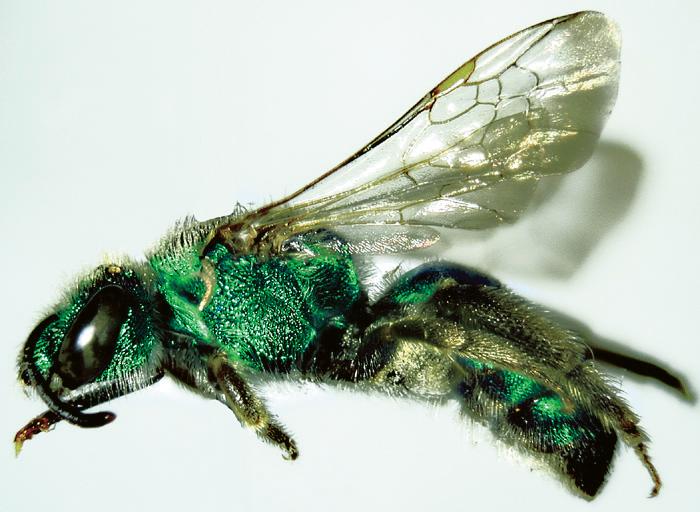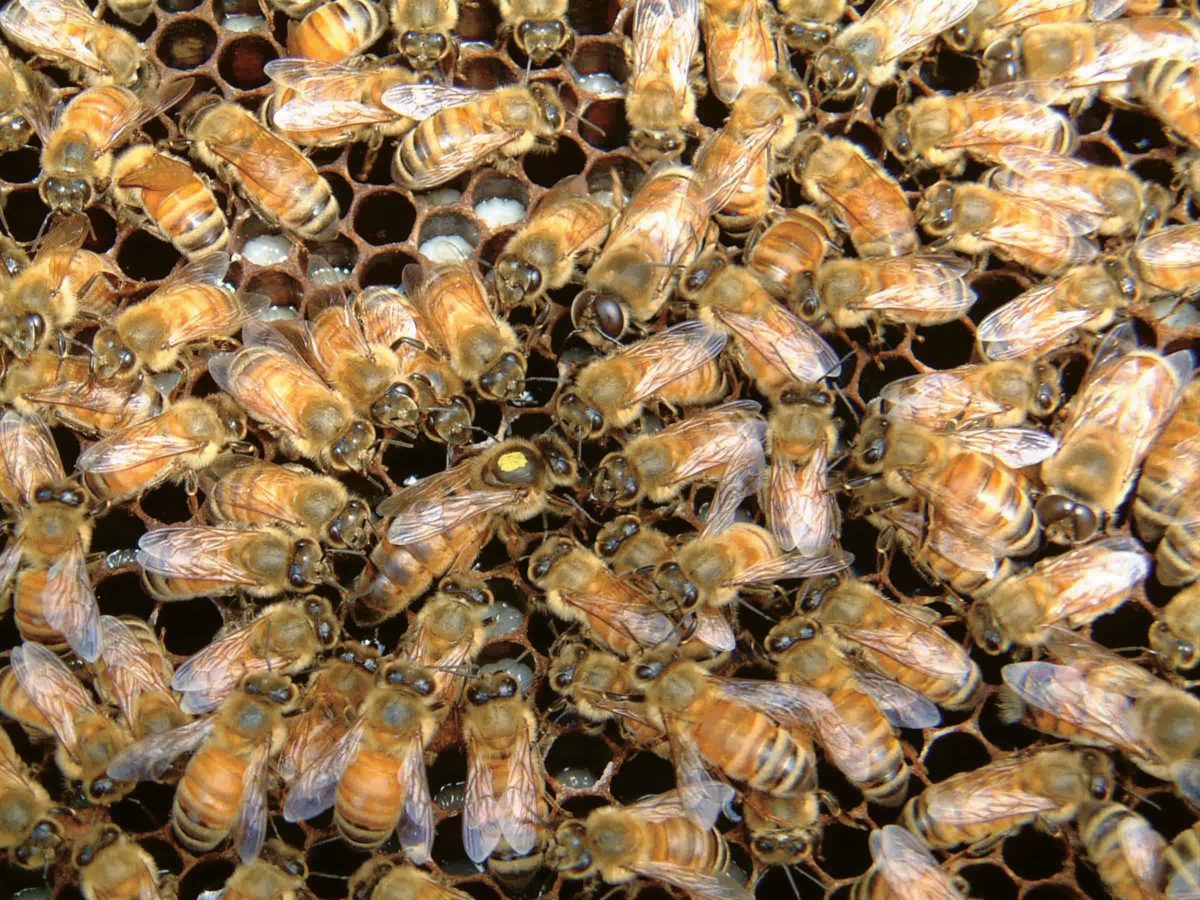
It is a curious fact that some insects tolerate living in close proximity to each other, often within a single nest. Within the order Hymenoptera, some species of wasps and bees, and all species of ants, evolved social behaviors, living in colonies and interacting in complex and sophisticated ways. However, most species of wasps and bees live strictly solitary lives (Figure 3.6). Some solitary bees and wasps aggregate their individual nests in one location, splitting the difference between going it entirely alone and having nest-mates.
Honey bees are probably the most well known of the social bees because they produce honey and have made headlines with Colony Collapse Disorder. Most people recognize bumble bees as they fly from flower to flower, but few people appreciate that they also are social. A honey bee colony is perennial; the queen and her workers live together year-round and survive together through hot summers and cold winters (Figure 3.7). In contrast, a bumble bee society is annual; the size of the group alternates between a single queen who hibernates underground during the winter months and a colony of individuals who live together in a nest during the summer. A honey bee colony is like a perennial tree; a bumble bee colony is more like an annual plant that begins from seed each year.
Three other bees described in this book— mason, leafcutter, and alkali bees—are solitary. Each female constructs her own nest and provides food for her offspring. Some females may aggregate their individual nests in a particular location, but they do not interact or help each other. In fact, the egg-laying female does not live long enough to see her offspring complete development; she dies leaving her legacy behind.

Why do some bees prefer to interact with each other while others can’t tolerate it? Why do only some bees live in a group? Apparently, it works just fine for most insects and most species of bees and wasps to go it alone. In the case of bees, however, they are successful and abundant when they have access to a diverse array of floral resources and ample places to lay their eggs. When these resources are limited, their populations may decline. Living in a group must be advantageous, especially in these limiting environmental conditions, or they wouldn’t do it. In fact, some bee species in the family Halictidae can be solitary in one environment and social in another. This gives us a clue that environment must have played a role in the early stages of social behavior. Way back when, if it was difficult for bees to find nesting sites—for example, hollow twigs or cavities or soil of the right consistency for digging a hole— some bees might have grouped together where these resources were adequate, thus increasing chances for survival. Also, if floral resources were patchy or scarce, it may have been helpful for populations of individuals to cluster where resources were rich. With a sting as a defense, a female could remain close to her developing offspring and defend them from predators or even from members of the same species that might want to stage a takeover of an already provisioned nest. These scenarios may help explain why some bees tolerate living in close proximity, and why they would be gregarious.
The next puzzle about group living is why members within the group would forego mating and reproduction, allowing one or a few females to reap the direct genetic benefits of laying all the eggs. Wouldn’t it make sense biologically for each female to have her own genetic offspring? Most scientists agree that for true colony life to evolve, for insects to interact within a nest and allow only one or more of the females to lay eggs, the group members within the nest must be related to some degree. If they aren’t initially related, in time they may come to share genes if one or a few females become the primary egg-layer(s). Sharing a majority of genes provides a sort of glue to hold the interests of the group together. What are the interests of the group? They are long-term—very, very long-term. To be successful, members of the group must have their characteristics (genes and how these genes play out as traits in particular environments) propagated in subsequent generations, for millennia to come. If they can’t reproduce directly by laying their own eggs, they can reproduce indirectly by helping their mother and sisters lay eggs. If more individuals of common descent can be produced in the long run by the counter-intuitive strategy of foregoing immediate personal reproduction, then long-term interests automatically kick in and persist as inclusive fitness benefits.
It is hard for humans to think about very long-term, evolutionary costs and benefits. For all the thinking we do, we tend to prefer thinking of short-term, more immediate benefits. Fortunately, insects don’t think the way we do. They respond to the environment and to each other, they learn simple and even complex things, but they do not think about thinking. This may be one reason for their very long-term success.
Within a social colony of insects, even with their shared long-term reproductive interests and overall cooperation, there is still conflict among individuals. This give-and-take among individuals, even among relatives, seems to be the crux of life. Cooperation and conflict is evident in all living things, from bacteria to elephants, so it is no surprise that life isn’t always peaceful in insect societies. There are always a few cheaters and thieves. There are always females that sneak in their own eggs when the primary egg-layer is not aware, or even at certain predictable times of year in full sight of the queen, as in some bumble bee colonies. How social insects balance conflict and cooperation is a fruitful and relevant area of study.
Honey bee and bumble bee societies, although different from each other, are rich and complex. They are female-based societies with no central authority. This fact comes as a surprise to many people: How can a society survive without a ruler? We call the egg-laying female a queen but she is not an authoritative figure. She has the privilege of mating and laying fertilized eggs, and so of directly propagating her genes, but she does not rule the roost, she does not bark out orders. Who rules? The short answer is all individuals in the nest rule themselves. They organize themselves based on innate behavioral patterns and information gleaned from interactions with nest mates and the environment. The society is self-organized as a complex, interactive network— as an emergent property. The individuals within the society constitute one level of organization, and the colony constitutes another level of organization, often quite different than the sum of the parts. The building blocks of the social colony are the behaviors of individual bees, but when the individuals come together, colony-level behaviors emerge. A honey bee colony can be considered as an organism, or superorganism, and many colonies in a landscape can be considered a community. Social insects are fascinating because they stretch the human mind to think outside our social and political spheres. They force us to learn something from very ancient and successful types of societies. They force us to consider their solitary origins. This is one reason, among many, to respect and protect bees, both solitary and social.
